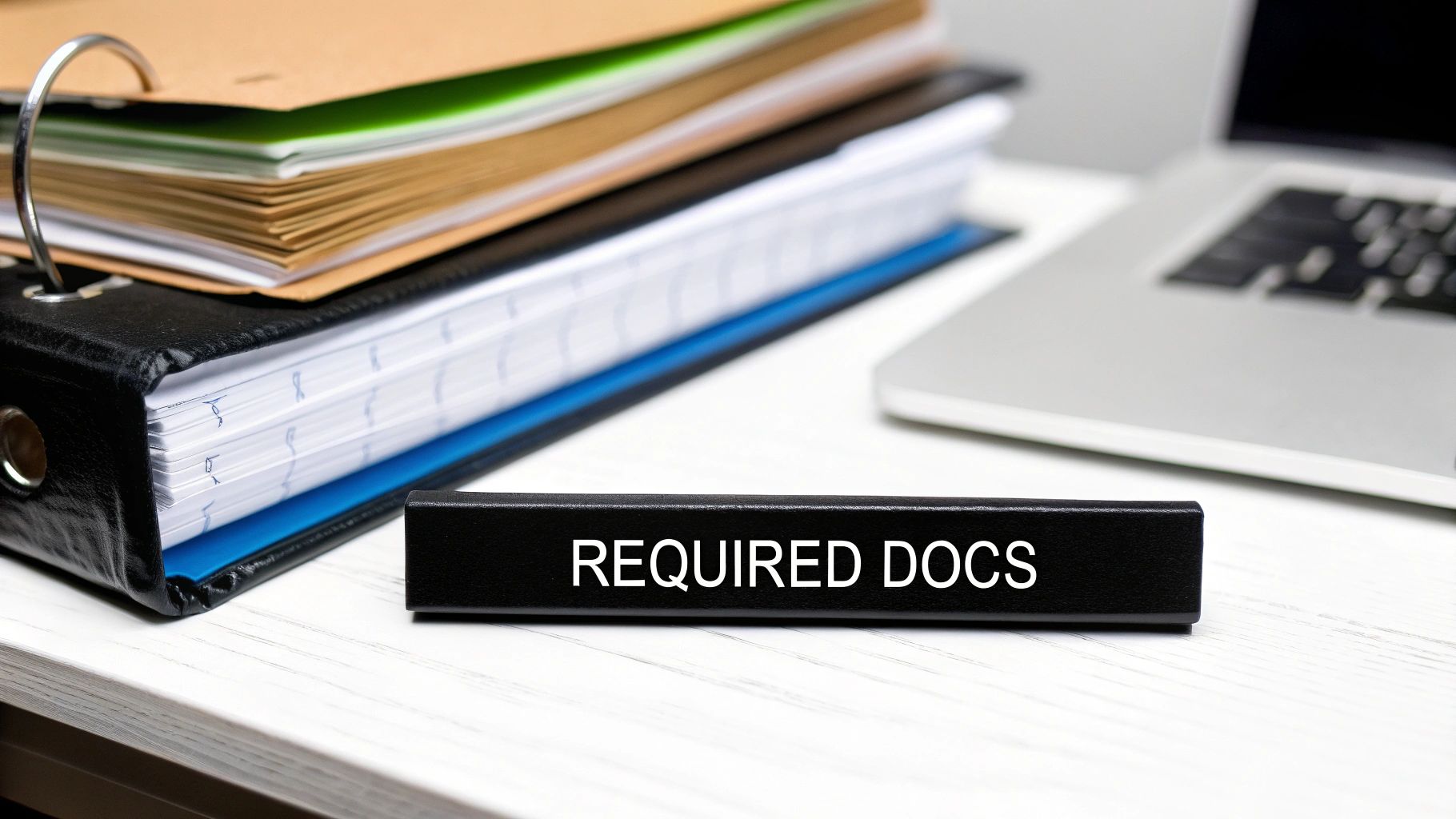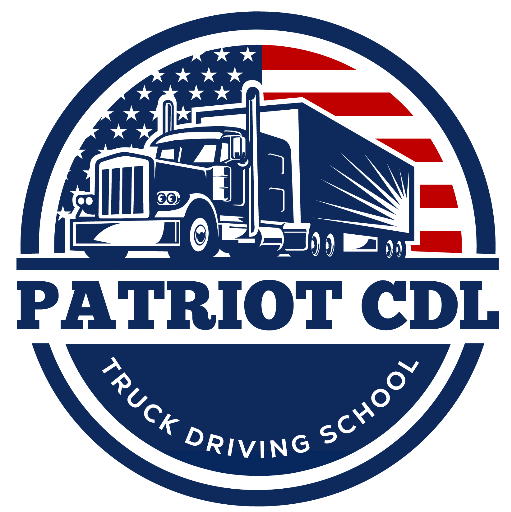If you're looking to drive a vehicle designed to carry 16 or more people (yourself included), you'll need what's called a Passenger (P) Endorsement on your Commercial Driver's License (CDL). It's a federal requirement that shows you’ve got the specialized skills to safely transport passengers, not just cargo.
What a Passenger Endorsement Actually Means for You
Before you even think about getting behind the wheel of a bus, let's break down what a P Endorsement really is. Think of it less as just another stamp on your license and more as a professional credential that says you're trusted with people's lives. It proves you understand the unique challenges of passenger safety, from conducting a proper pre-trip inspection on a passenger vehicle to managing emergencies with a cabin full of people.
This isn't just about adding a new qualification; it’s about stepping up to a much higher level of responsibility. These standards are set at the federal level by the Federal Motor Carrier Safety Administration (FMCSA) because everyone agrees that moving people carries a different, more profound risk than moving boxes.
The Journey to Earning Your P Endorsement
Getting your P Endorsement is a clear, structured process. It's designed to confirm you have what it takes to handle the job. The journey tests you on more than just your driving ability—it dives deep into safety protocols, the mechanics of passenger vehicles, and critical emergency procedures. Every driver who wants to transport passengers has to go through these same key steps.
The core idea behind the P endorsement is straightforward: carrying passengers requires a specific set of skills. You have to be ready for everything—from the daily routine of loading and unloading to handling the unexpected, all while keeping every single person on board safe.
To give you a clearer picture of what’s involved, let's map out the process. The table below breaks down the main steps, what each one involves, and the key focus area you'll need to concentrate on.
Passenger Endorsement Process At a Glance
| Requirement Category | What It Involves | Key Focus Area |
|---|---|---|
| Eligibility & CDL | You must already have or be eligible for a CDL in your state. | Holding a valid, current Commercial Driver's License. |
| Written Knowledge Test | A multiple-choice test on passenger safety, vehicle inspection, and emergency protocols. | Studying your state's CDL manual, specifically the passenger transport section. |
| Skills Test | A practical, hands-on test in a passenger vehicle. | Demonstrating pre-trip inspection, loading/unloading, and on-road driving skills. |
| Background Checks | Federal and state-level background checks are often required. | Maintaining a clean driving and criminal record. |
| Fees & Documentation | Paying application, testing, and endorsement fees, and providing required ID. | Gathering all necessary paperwork and being prepared for associated costs. |
This table provides a high-level overview, but seeing the initial steps laid out visually can also be helpful.

This graphic walks you through the foundational stages: making sure you're eligible, getting your documents in order, and officially submitting your application. Nailing these first steps paves the way for the real test of your abilities—the written and skills exams where you'll prove you’re ready for the responsibility.
Laying the Groundwork: Your First Steps to a Passenger Endorsement
Before you even think about the specific tests for a passenger endorsement, you need to have a solid foundation in place. Think of it like building a house—you can't put up the walls and roof until the foundation is poured and solid. These initial steps are non-negotiable and ensure every driver carrying passengers is responsible, safe, and physically up to the task.
First and foremost, you must hold a valid Commercial Driver's License (CDL) for the class of vehicle you intend to drive. If you're new to the world of commercial driving, you'll have to start by meeting your state's basic CDL requirements. This also means your driving record will be put under the microscope. A clean record isn't just a suggestion; it’s a requirement that proves you have a history of being a safe driver.
Passing the Medical and Security Hurdles
Once you have your CDL, the next step is proving you're medically fit for the job. This means passing a Department of Transportation (DOT) physical exam to get your medical examiner's certificate. It’s a thorough check-up to make sure you have the physical stamina and health to safely handle a large vehicle and its precious cargo.

You'll also undergo a comprehensive background check. This is a standard procedure designed to screen for any criminal offenses that would automatically disqualify you from transporting passengers.
It's worth noting that the standards get even higher if you plan on driving a school bus. For the School Bus (S) Endorsement, you'll face a much more rigorous background screening, often managed by the Transportation Security Administration (TSA), to guarantee the safety of children.
Clearing these initial hurdles is the first major milestone. It confirms you're a qualified candidate and clears the path for you to focus on the next phase: the written and skills tests where you'll prove your specific expertise in passenger transportation.
Passing the Passenger Endorsement Knowledge Test
Think of the written knowledge test as the first real hurdle you'll clear on your way to getting a passenger endorsement. This is where you prove you’ve got the book smarts down cold before you even think about letting a single person step onto your bus. It’s not just about memorizing rules; it’s about understanding why those safety regulations are so critical.
The test itself zeroes in on the unique challenges of carrying people. You won’t see many questions from the general road test here. Instead, you'll be quizzed on scenarios that demand quick, safe decisions to protect every passenger on board.

Core Topics You Must Master
To ace this test, you have to be rock-solid on a few key topics. Your state's CDL manual is your bible, but you’ll want to pay special attention to the passenger-focused chapters.
- Vehicle Inspection: This isn't your standard pre-trip. You'll need to know how to inspect everything specific to a passenger vehicle, from checking emergency exits and seats to making sure tires are safe for the people you're carrying.
- Loading and Unloading: There’s a right way and a wrong way to get people on and off a bus. You must master the proper procedures, especially for managing the "danger zone"—that critical space around the bus where accidents are most likely to happen.
- Emergency Procedures: What do you do if there's a fire? Or an accident? You'll need to know exactly how to handle evacuations and use all the emergency equipment correctly and without hesitation.
- Railroad and Drawbridge Crossings: The rules for crossing tracks and drawbridges are much stricter when you have passengers. The test will ensure you know these protocols inside and out.
The Federal Register makes it clear why these rules are so important. They officially define a passenger vehicle as one designed to carry 16 or more people (including the driver). This is what separates a bus from a large van or passenger truck.
Proven Study Strategies
Let’s be honest, just reading the CDL manual from front to back is a surefire way to get bored and forget everything. A smarter approach is to work with a plan.
Start by taking a few practice tests before you dive deep into studying. This is the fastest way to figure out what you don’t know. Once you’ve identified your weak spots, you can go back to the manual and focus your energy on those specific sections.
And don't forget the basics! The passenger endorsement builds on everything you've already learned. It’s always a good idea to brush up on the fundamentals. A strong foundation makes mastering the passenger-specific material much easier.
Mastering the Hands-On Skills Test
Once you've cleared the written exam, it’s time to show what you can do behind the wheel. The hands-on skills test is where your training really shines, proving to examiners that you can safely handle both the vehicle and, most importantly, the people inside. Think of it less like a standard driving test and more like a specialized audition for a professional driving career.
The test is broken down into three specific parts. Each one is designed to evaluate a crucial aspect of your abilities as a passenger vehicle operator. You'll need to pass all three to get that P endorsement on your CDL.

The Pre-Trip Vehicle Inspection
Before the engine even turns over, your test has already begun with the pre-trip vehicle inspection. This isn't just a quick walk-around; it’s a deep dive into the vehicle's safety systems. For a passenger vehicle, you’re responsible for checking unique safety features that standard trucks just don't have. This means making sure all emergency exits work, every seat is bolted down securely, and the passenger entryways are clear and safe.
The point here is to prove you can spot a potential hazard before it becomes a real problem on the road. Examiners are looking for a systematic, thorough check that shows you prioritize passenger safety above all else.
A sloppy or incomplete inspection is one of the quickest ways to fail the test on the spot.
Basic Vehicle Control
Next up, you'll move to the basic control maneuvers portion of the test. This happens on a closed course, safely away from public roads. Here, the examiner will have you perform specific skills like backing up in a straight line, making tight turns without hitting a curb, and weaving through a serpentine cone course.
The goal is to demonstrate that you have total command of the vehicle's size and dimensions. With passenger vehicles, there's an added emphasis on smooth acceleration and braking—proof that you can deliver a comfortable ride, not just get from point A to point B.
The On-Road Driving Test
Finally, it's time for the main event: the on-road driving evaluation. This is where everything comes together in real-world traffic. The examiner is watching for more than just your ability to follow traffic laws.
They'll be paying close attention to passenger-specific skills, including:
- Properly stopping at railroad crossings and designated bus stops.
- Making safety announcements at the right moments and speaking clearly.
- Maintaining a professional demeanor and managing distractions without alarming passengers.
Your ability to execute smooth stops and starts is absolutely critical, as it directly affects both the safety and comfort of everyone on board. This final part of the test confirms you're truly ready for the huge responsibility of transporting people.
Navigating the Fees, Paperwork, and Renewals
You’ve passed your tests, which is a massive hurdle to clear. But before you can start driving, there's one last step: tackling the paperwork and fees at the DMV. This is where attention to detail really matters. Think of it as the final inspection before a big trip—get everything right now to avoid frustrating delays later.
When you head to the DMV, you'll need to bring a specific set of documents. While requirements can vary a little from state to state, you should be prepared with your current Commercial Driver's License, your DOT Medical Examiner's Certificate, and proof of U.S. citizenship or lawful permanent residency. Having all your ducks in a row makes the whole process go much more smoothly.
Breaking Down the Costs
Getting your passenger endorsement isn't just one single payment. Instead, the total cost is a combination of several smaller fees that cover each part of the process.
- Application Fee: This is the upfront cost just to get your request into the system.
- Knowledge Test Fee: You’ll pay this to take the written passenger endorsement exam.
- Skills Test Fee: This covers the hands-on, behind-the-wheel portion of your test.
- Issuance Fee: The final charge to physically print your new CDL with the P endorsement on it.
Costs can change quite a bit depending on where you live, so it's always smart to check your local DMV’s website for the most current fee schedule.
The strict requirements for a passenger endorsement aren't just red tape. They're a critical part of a worldwide push for public safety. By making sure drivers have these specific skills and knowledge, authorities are building a system that leads to safer roads and fewer accidents.
Staying Current with Renewals
Once you have your P endorsement, you can't just set it and forget it. It’s tied directly to your CDL, which means when your license is up for renewal, so is your endorsement. Keeping up with this is essential to legally transport passengers.
Renewing usually means having a valid medical certificate on file. In some situations, especially if you let your endorsement lapse, you might even have to retake the written knowledge test.
Answering Your Top Questions
Even with a step-by-step guide, you're bound to have a few specific questions pop up. Let's tackle some of the most common ones we hear from drivers looking to get their passenger endorsement.
How Long Is a Passenger Endorsement Valid?
This is a great question. Your Passenger Endorsement (or P Endorsement) doesn't have its own separate expiration date. Think of it as being permanently attached to your Commercial Driver's License (CDL).
As long as your CDL is valid, your P Endorsement is too. When it’s time to renew your license, you’ll renew the endorsement right along with it, provided you still meet all the state's requirements.
Can I Get an Endorsement with Points on My License?
This is a common concern, and the honest answer is: it really depends. A couple of minor speeding tickets might not be a deal-breaker.
However, states are extremely serious about passenger safety. Major offenses on your driving record—things like a DUI, reckless driving, or leaving the scene of an accident—are almost always automatic disqualifiers. Your best bet is to check directly with your state's DMV to see exactly how your driving history affects your eligibility.
The core difference between a P and an S endorsement is specialization. Think of the P endorsement as the general qualification for carrying passengers, while the S endorsement is an advanced certificate specifically for the immense responsibility of transporting children safely.
What Is the Difference Between a P and an S Endorsement?
While both endorsements are about transporting people, they authorize you to do very different jobs.
- P (Passenger) Endorsement: This is your ticket to operating most commercial passenger vehicles. We're talking city buses, tour coaches, and large airport shuttles.
- S (School Bus) Endorsement: This is a specialized credential required only for driving a school bus. To get an S endorsement, you must first qualify for the P endorsement. From there, you'll need to pass another knowledge test, a separate skills test, and a much stricter background check focused on the safety of children.
Do I Need a P Endorsement for a Small Shuttle Bus?
It’s not about how big the vehicle looks, but what it was built for. Federal law is crystal clear: if a vehicle is designed to transport 16 or more people (including you, the driver), you absolutely need a P endorsement.
This rule catches a lot of common vehicles, like hotel shuttles, larger airport vans, and community buses. And remember, even if the shuttle you drive is an automatic, you might need to get certain restrictions lifted from your CDL. If you see an "E" restriction on your license, there are courses that can walk you through the process of getting it removed.
At Patriot CDL, we're committed to getting you on the road to a successful and rewarding career. Our expert-led training programs are designed to help you master every requirement for your CDL and endorsements.
